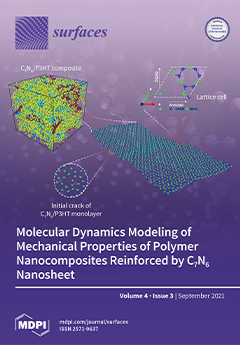Carbon-nitride nanosheets have attracted remarkable attention in recent years due to their outstanding physical properties.
is one of the hotspot nanosheets which possesses excellent mechanical, electrical, and optical properties. In this study, the coupled thermo-mechanical properties of the single
[...] Read more.
Carbon-nitride nanosheets have attracted remarkable attention in recent years due to their outstanding physical properties.
is one of the hotspot nanosheets which possesses excellent mechanical, electrical, and optical properties. In this study, the coupled thermo-mechanical properties of the single nanosheet
are systematically investigated. Although temperature effects have a strong influence on the mechanical properties of
monolayer, thermal effects were not fully analyzed for carbon-nitride nanosheet and still an open topic. To this end, the presented contribution aims to highlight this important aspect and investigate the temperature influence on the mechanical stress-strain response. By using molecular dynamics (MD) simulation, we have found out that the
monolayer’s maximum strength decreases as the temperature increase from 300 K to 1100 K. In the current contribution, 5% to 15% volume fractions of
/P3HT composite were employed to investigate the
reinforcing ability. Significantly, the uniaxial tensile of
composite reveals that
can enhance the maximum strength of the composite to 121.80 MPa which is 23.51% higher than the pure
matrix. Moreover, to better understand the enhanced mechanism, we proposed a cohesive model to investigate the interface strength between the
nanosheet and P3HT matrix. This systematic study provides not only a sufficient method to understand the
thermo-mechanical properties, but also the reinforce mechanism of the
reinforced nanocomposite. Thus, this work provides a valuable method for the later investigation of the
nanosheet.
Full article





